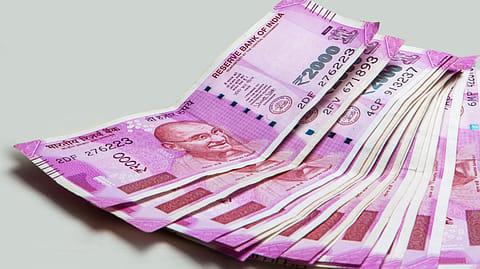Banks may get ₹1.6 lakh cr deposits after ₹2000 note withdrawal: RBL Bank
RBL Bank does not see any significant risks to inflation with the withdrawal of ₹2000 notes.

India's banking system could see an inflow of ₹1.5-1.6 lakh crore in the form of deposits if ₹2000 notes worth ₹3.62 lakh crore are currently in circulation with the public, according to RBL Bank.
During demonetisation, bank deposits shot up and one can expect a similar trend to play out, just that the quantum of flow is likely to be fragmented and likely to be of less magnitude in terms of flows as the RBI stated that the transactions in the ₹2000 was not common, RBL Bank economist Achala Jethmalani says in a note.
A lower amount in circulation could mean lower incremental deposits flow to the banks, Jethmalani adds.
According to the note, the economic impact of the withdrawal of ₹2000 notes is likely to be limited. During demonetisation in 2016, ₹14 lakh crore worth of currency was no longer legal tender overnight. Around 43%-45% of the ₹14 lakh crore came to the system before the RBI started to suck out the excess system liquidity by way of the Market Stabilization Scheme (MSS), the lender says.
This time the situation is likely to be different since the ₹2000 note stands withdrawn and continues as legal tender. "The timeline to do so is longer, the next 4-months (till September 2023), thereby the impact is likely to be limited. Unlike last time, the digital transactions have been hefty, suggesting that the transition for note replacement, is likely to be smoother," says RBL Bank.
The gradual withdrawal of 10.8% or ₹3.62 lakh crore of total currency in circulation, which is in the form of the highest denomination note of ₹2000, from the system is likely to add to the banking system liquidity in 2023, the private lender says.
Since notes are likely to return to the system and shops are likely to show reluctance to collect those notes in payments, consumption is unlikely to shoot up due to this move, the Mumbai-headquartered bank says.
Recommended Stories
"Do not see any significant risks to inflation as do unlikely to see production or consumption get impacted. The deceleration in settlements to vendors or obstructions in supply chain in smaller towns where banks accessibility is far could prove to be the pain points. However, we do not see a significant impact on growth as such," it says.
On interest rates, assuming the banking system receives a surplus in liquidity over the next few months, then the rates could see softening, especially on the shorter end of the curve, RBL Bank notes.
The banking system liquidity surplus due to the recent RBI dividend to the government and the return of ₹2000 notes to the banks as deposits over the next four months could mean that the rates on the shorter end of the yield curve could see a drop, says the private bank. The RBI board last week approved the transfer of ₹87,416 crore as surplus to the central government for the financial year 2022-23.
The Reserve Bank of India (RBI) on May 19 announced the withdrawal of ₹2000 denomination notes from circulation, saying they are "at the end of their estimated life-span of 4-5 years" and "not commonly used for transactions". The central bank urged members of the public to deposit ₹2000 notes into their bank accounts or exchange them into banknotes of other denominations at any bank branch up to September 30, 2023.
(INR CR)